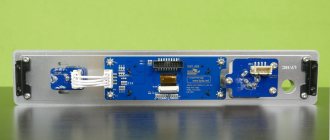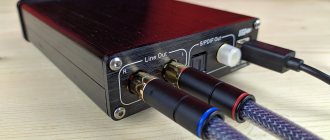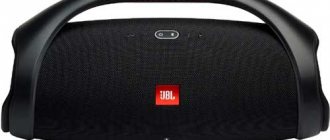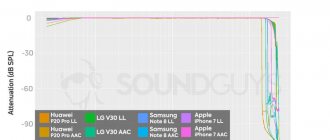Somehow it turned out that I was not familiar with the work of the Gustard company, despite the fact that they released quite a lot of popular devices. It's time to fix this, especially since I got my hands on a new product, their X16 DAC. The company's plans include the release of several devices in the mid-price segment, united by a common design. It is assumed that the user can assemble a small “stack” of a desktop setup using the components that he needs. In addition to the X16, the line also includes the H16 headphone amplifier and the S16 streamer. Perhaps there will be other devices, but so far I have not seen any clearly announced plans.
The X16 itself turned out to be very functional; its “heart” is two ES9068AS chips, supported by an OPA1612a op-amp. XMOS XU-216 is responsible for USB and “controls” the operation of Intel Altera. Not without the necessary “delights” such as femtosecond master oscillators and high-quality capacitors with resistors. In addition to supporting high resolution (768 kHz/32 bit and DSD512), the DAC also “understands” MQA with full decoding. An additional bonus is the presence of Bluetooth (including LDAC codec) and the remote control included in the kit.
The price tag for a device so rich in capabilities was chosen to be quite adequate; you can buy a Gustard X16 for $500.
INTRODUCTION
When it comes to complex multi-component tracts, there is always a question of consistency and matching.
Each of the elements of the path, be it headphones, DAC, amplifier, or even a digital player, has a share of influence. Significant or barely noticeable - it doesn’t matter. As a result, it becomes decisive to select the parts of the tract so that they complement each other. And they did not create repeated emphasis on key characteristics. Take fat CA Andromeda Gold, a cable like Hulk and a player with warm and massive bass. The result will be far from balanced sound. But it’s worth changing the source, reconsidering the choice of cable - and the synergy of the bundle will increase. But what about the acoustically transparent elements of the tract? This is both difficult and simple at the same time. The difficulties of selection are imposed only on the headphone-source pair. And the Gustard H16 is well suited to being a device that won't force you to rethink the rest of your setup. Just like the Topping A90 I recently reviewed. Both devices strive for neutrality and acoustic neutrality. But they do it in a slightly different manner.
Having a common character, the devices clearly demonstrate the difference in approaches. Gustard traditionally does not make devices with “character”. The company prefers sound without obvious coloration. Topping follows a similar concept in the upper segment. But at the same time he never hides his craving for beautiful performance characteristics. Go look for an amplifier similar to the A90 by the numbers. Correction: plus or minus in the same budget.
Today we will take a look at the Gustard H16, and also compare it with the Topping A90. Both devices came out worthy of attention, with their own strengths. So if you have headphones that are difficult to drive and you are looking for an amplifier that can pump them up, then you are in the right place.
Like Topping, the Gustard H16 is one of the twins. Gustard fired a doublet, releasing the X16 DAC and our today's hero. Of course, the developer tuned the H16 as much as possible for synergy with the X16. But with other sources the Gustard H16 sounds full.
Example tracks
Counting Crows - Elevator Boots A fresh track from the famous Berkeley rock band that sounds both modern and nostalgic. The musicians did not follow fashion and, despite being inspired by the “classics,” they did not create a dirty “vintage” sound. So this track needs a good source, and the Gustard X16 does a great job here, handling guitars, vocals and keyboards very well.
Jean-Jacques Milteau — She Thinks I Still Care Despite its apparent simplicity, the harmonica is one of the main components of “real blues,” and the Frenchman Jean-Jacques Milteau is an outstanding virtuoso of this instrument. Almost every album of his is not only well played, but also well recorded, so the hero of our review has a place to demonstrate his technical skills, because instruments that require technical presentation are a dime a dozen here.
Alfa Mist - Run Outs Despite the fact that the work of the London producer, pianist and MC is clearly inspired by classical jazz, genre-wise it extends wider than any framework, incorporating any influences and trends. So if you love beautiful and complex music, grab a more technical source like the Gustard X16, yes, and enjoy this inspired album.
PACKING AND EQUIPMENT
Traditionally, the packaging of Gustard devices smacks of asceticism. The amplifier comes in a compact box made from recycled cardboard. Almost without any printing. With the exception of the logo in the form of a stylized letter G on the lid and a minimum of commercial and technical information on the ends of the box. Under the polyethylene cover the main contents await us.
The delivery set, like the packaging design, is also not shocking. This is the amplifier itself, the power cable, and the warranty card. I'm glad that the remote control is included. He is familiar to Gustard. The A22 and X26 included similar remote controls. As with many other devices from the Middle Kingdom. Like chandeliers, TV set-top boxes and other things.
If the Topping A90 looks clearly more solid in terms of packaging, the remote control is still an undeniable plus. I myself spent many hours at a considerable distance from the H16, and having a remote control was a significant advantage. Batteries are not included, so consider purchasing a pair of “pinky” AAA batteries.
The power cable is standard. And personal experience suggests that upgrading it will definitely not make things worse. But these are such subtle matters that I will not recommend anything specific.
As you can see, the package could be called meager if it weren’t for the remote control, which was sometimes sorely lacking with the Topping A90. By the way, the included remote control can also control both the X16 DAC and the S16 streamer.
GUSTARD H16 DESIGN
The amplifier is made in the same style as the X16. Comes in two colors - black and silver. I got the silver version. The body is solid. It is monolithic, made from a single piece of anodized aluminum. It is polished on CNC machines, therefore it has a smooth surface. The chassis is mounted on powerful rubberized legs. The amplifier feels confident and stable on the surface. Weight also contributes to this. Although it weighs 2.5 kg, which is exactly 1 kg less than Topping, it feels heavier.
They are very close in size. 220*160 and 220*170 in favor of Gustard. However, the H16 is slightly taller - 50mm versus 45. Both amplifiers fit easily even on a very compact tabletop and do not require much space. In a word, the devices are compact and ergonomic.
The front panel is recognizable. The brand is easily identified by the familiar pattern of equalizer stripes on the left side of the panel. If the Topping A90 is replete with controls, the Gustard H16 is more minimalist. The only controls here are a wheel and a button. The button is used to select input (short press) and gain (long press). The wheel allows you to adjust the volume and select the gain. Its movement is easy, each division of the volume scale has a clear click.
The volume level is displayed on a miniature OLED display. It also serves to display the selected input and gain level as you change them. The screen is out of the ordinary - thank God it is there. Of course, his role is minimal, but he copes with it. The values are visible even from a distance.
On the front panel we also see four headphone outputs. One unbalanced at 6.3mm and three balanced. XLR, 3.5mm, and Pentaconn are available here. There is no 3.5mm adapter included, but I’m sure every self-respecting audiophile has one. Therefore, the switching capabilities of the H16 are extremely wide.
The back panel echoes this. Like the Topping A90, there are two pairs of inputs and outputs. RCA and XLR. The amplifier has a fully balanced circuit. In addition to being a headphone amplifier, the H16 should also be considered as a balanced preamp for stationary equipment. The rear panel also contains a power socket and a voltage switch. Don't forget to check it again before turning it on for the first time!
If the Topping A90 had a power control switch on the front panel, it is not here. Unfortunately, the Gustard H16's power can only be turned on and off via a two-way switch on the rear panel. This creates inconvenience in some cases. Especially if the amplifier is installed in a rack with limited access. This aspect of operation did not spoil the overall impression for me. However, my DAC with similar power management is in a sort of rack. Convenience is average.
Specifications
- DAC: 2 × ES9068AS
- I/V: OPA1612a
- USB: XMOS XU-216
- Maximum Resolution: 768 kHz/32 bit, DSD512, MQA Full Decoder
- Bluetooth: 5.0 with support for SBC, AAC, aptX, aptX-LL, aptX-HD, LDAC codecs
- Frequency range: 20 Hz – 20 kHz ±0.08dB
- Inputs: USB, Coaxial, Optical, AES/EBU, IIS (HDMI)
- Outputs: 2 × RCA, 2 × XLR
- Output voltage: 2Vrms on normal, 4Vrms on balanced
- Dimensions: 220 mm × 170 mm × 50 mm
TECHNICAL SPECIFICATIONS AND FEATURES GUSTARD H16
The Gustard H16 is comparable in performance characteristics to the Topping A90. That is, it should be classified as a powerful amplifier. Very powerful, eliminating any questions about strengthening. The amplifier provides up to 3.7 W of power at an impedance of 64 ohms and 566 mW at 600. Topping A90 at 600 ohms provides 500 mW. The output impedance is similar - 0.1 Ohm on the unbalanced output and 0.2 Ohm on the balance. Gustard H16 SNR 118 dB for headphone output and 120 for preamplifier. Which is slightly less than Topping's 145 dB on both outputs. The Gustard H16's harmonic distortion and noise performance is excellent. 0.0005% and 0.0004% for headphone and pre outputs respectively. But even it pales in comparison to Topping with its 0.00006-0.00009% depending on the resistance of the headphones. It's no secret that Topping focuses on numbers and measurements. It's not good or bad, it's a fact.
The preamplifier and power stage are built on one LME49722 and two LNE49724 chips. OPA1642 and OPA1678 are used as a buffer. There is also a digital “brain”. This is an STC MCU microcontroller and FPGA from Altera. They are responsible for processing the audio signal
The Gustard H16 features separate power supply for the balanced circuit. Separate toroidal transformers are responsible for the left and right channels. This ensures the purity of the power supply, as well as the dynamics and speed of the amplifier stages.
In response, Topping A90 can counter NFCA amplification. Or composite amplification with nested feedback. But what interests us more about you is not the numbers or the filling. The difference in numbers at the level presented in the H16 vs A90 pair cannot be heard with the ears. Neither mine, nor, most likely, yours. And whatever the filling, it loses its meaning if the device “does not play.”
Power is power, but how does the H16 work with sensitive headphones? With the Solaris SE through a balanced connection at low gain there was very little noise. Otherwise, there is excellent stage geometry, control and sound purity. I note that at low volume levels, quiet clicks are noticeable when adjusting it. They were not seen with full-size models. This may be due to the volume being too low. With Solaris it did not rise above 12 units.
SOUND GUSTARD H16
The Topping A90 impressed with its absolute acoustic transparency. This unit was completely absent from the tract in terms of its influence on the final sound. At the output we received a signal many times amplified, but exactly the same as at the input. This is a huge plus if you don't want to adjust the nature of the source and headphones. While listening to the path from the A90, you listened to your source and headphones.
The Gustard H16 has a similar philosophy. This is, as they say, “wire with reinforcement.” But still not quite. Gustard has a small but very competent influence on the sound. When we do not get obvious color, but there are touches that add completeness to the picture. Roughly speaking, these are not new objects on the canvas or an inversion of tones. It is rather an improved elaboration of geometry and increased clarity of the picture.
Listening to a couple of wonderful Fostex, TH909 and TH900mkII, I caught myself thinking that I involuntarily prefer Gustard. Involuntarily - when I’m not “looking for fleas” or catching differences in the sound of headphones or amplifiers. But simply for the consumption of material. And this is not about quality or level. But the fact is that my DAC provides a very smooth, balanced and neutral sound. Tonally and emotionally. Timbrally accurate and with very cool stage geometry. But this same neutrality with Topping becomes the main leitmotif in the sound of the setup. Gustard H16 sounds less bland and dull. When using other sources, less neutral and with little color, the Topping A90 conveyed all these moments wonderfully.
That is, this is the case when the source is perhaps somewhat more neutral than desired. And Gustard H16 becomes a “pill”. The one that is red instead of blue. Of course, in its main form, the DAC suits me, because its character allows the speaker amplifier to reveal itself better. Moreover, technically, there are no questions about any aspect of the sound of the Aune-Topping-Fostex combination. But replacing Topping with Gustard H16 in the setup immediately affects a number of points.
Firstly, just a little, but Gustard sounds not even brighter, but more contrasting on the high-frequency and high-frequency frequencies. We get slightly emphasized contrast and sharpness of contours. Secondly, also due to this, with H16 the separation of plans is better expressed in the path. The stage is built in depth in the same way, but with a more defined echelon. Thirdly, the extremely linear LF output from the SS3602 receives a small addition in mass at the H16. If the picture doesn’t change in terms of depth, then in terms of mass at the lowest frequencies, yes. Not much, but enough for this fact to be reflected here.
The devices are not twin brothers. They have similar characters and one might even think of some kind of kinship. But the maximum is general “education.” Rather, they are half-brothers raised in the same house. Remember this simple comedy with Will Farrell and John Reilly? The analogy is very useful. Pharrell sang and Riley drummed. Besides, Pharrell is no stranger to sticks in real life.
Otherwise, both amplifiers are very similar. Both are technical, have outstanding detail for their price, are transparent and convey the character of the source. To some extent, the A90 is more focused on “cloning” the sound of the source. In turn, Gustard H16 is somewhat less accurate in repetition. But this only concerns a slightly greater sound contrast. It's a little warmer, more massive, more involving. All these “tweaks” are so carefully produced that the amplifier ultimately retains its neutral character and smooth signature.
It reminds me of analogues with covers. There are songs that sound equally great both in the original and in the cover version. For example, Hurt by Johnny Cash is at least as good as the original by NIN. Or The Man Who Sold The World. There will be fans of both the original and the cover. So do those who have never heard of the original. Same with Topping and Gustard. Someone's taste and, more importantly, setup will require absolute transparency from the amp. And someone else’s - on the contrary - the sensations of his work in the setup. And not only due to increasing signal power. Suum cuique.
SCENE
Here the situation is similar to what we had in the setup with Topping A90 as an amplifier. The scene is much more dependent on the source. However, I want to once again emphasize the excellent work of the Gustard H16 with space, regardless of the source. Firstly, there is depth. What I already wrote about. The amplifier emphasizes the separation of shots somewhat more clearly, while maintaining the desired depth of presentation. Due to this, the intended separation is perceived in a more effective manner.
As for the width, here too the amplifier is characterized by some expansion of the walls and expansion of the stereo panorama. Perhaps those digital “brains” that are scattered across the H16 board are precisely the ones responsible for these games with space. Or maybe not. But who cares if it ends up sounding great. Sweeping around the edges and very impressive in depth.
A small illustration. Here, against the background of Topping A90, the same more pronounced contrast of layers and clearer positioning of images are noticeable. The scene doesn't feel any deeper. Overall, H16 presents the composition in a more multi-layered and exciting way. What’s remarkable is that the amplifier manages to emphasize the holographic nature inherent in the headphones. This applies to both Solaris SE and top-end Fostex. The effectiveness of the Solaris presentation is especially noticeable on the H16. Topping A90 is more refined and less prone to even slight exaggeration.
LOW FREQUENCIES
The Gustard H16's bass is excellent. It is deep and easily copes with very textured low-frequency sources. With their texture rendered, the resolution of the Gustard H16 is truly high. Of course, its performance depends almost entirely on what the source is capable of. For example, for fun, I hooked up the H16 Hiby R3 (not Pro). With it the amplifier sounded smoother than with the Lotoo paw 6000 and even more so with the Dacportable. And in particular - Aune X8.
However, the amplifier also makes its contribution. Due to the already mentioned pleasant massiveness of the sub-bass region and a slightly warm presentation. This small amount of influence can add those subtle touches that will take your setup to perfection. Of course, “his” perfection.
Otherwise the situation is similar to the one I described with Topping A90. The amplifier provides absolute control. It controls every air movement, every sound and after-sound. Another thing is that with Lotoo the bass became somewhat fatty. Especially with Fostex, which have an accentuated and massive “bottom”. The serving became more flavorful than neutral. However, with Dacportable the situation has changed for the better. To that articulation and dynamics, the Gustard H16 also added a little weight. I have already mentioned the wonderful synergy with Aune. She is wonderful and claims to be exemplary.
A track with a rather rich middle, warm, intimate, like breathing, moist. But still having a solid bass line. The lower bass area is saturated first. The Gustard H16 not only conveys the depth and texture of the low frequencies, but also conveys the mass a little better than the Toping A90 does. The result is a recording that still sounds accurate and transparent, but with more flavor and impact. The linearity of the low frequencies here ensures their multi-layered presentation. Despite the slight saturation in mass, the range remains transparent and informative.
MIDDLE FREQUENCIES
The Gustard H16 is crystal clear and piercingly detailed in the midrange. At the same time, it is absolutely even in sound at the junctions with lower and mid frequencies. This means that by selecting headphones you can ensure exactly the mid-frequency delivery you want. I got delicious, layered midrange with excellent resolution from the H16 paired with the Solaris SE and the tonally very similar TH900mkII. The source in the “ideal combination” was Aune X8. Dynamics, resolution, separation of plans, but at the same time musically, seamlessly. The sound in the midrange is literally alive, pulsating. The timbres are natural, but that presentation, the sound itself, is not naturalistic, but beautiful. Live performance can hardly be called truly beautiful, with rare exceptions, of course. But with a high-end setup you can get natural timbres and an emasculated, polished sound. Tasty, beautiful, but precise at the same time. The Gustard H16 is doing great with this.
Moving on to the TH909, the Gustard H16 reproduces one of the features of the headphones perfectly. Namely, a certain piquancy of the high-frequency frequencies and an extremely open and transparent midrange region as a whole. The H16 is just as neutral as the A90, but again emphasizes the contrasts a little more. It doesn't work like Instagram filters, but rather like fine-tuning. Not even tonal balance, but tuning shadows, exposure and contrast. Light changes that give the picture more aesthetics.
The A90 is wonderful here in its straightforwardness and impartiality. It is in no way inferior to the H16 and does not try to surprise with anything. In turn, H16 cannot be called bright. All this influence does not affect the final perception of the sound as bright. Like warm or cold. The H16 sounds a little warmer, but not enough to call it “warm.”
I personally liked this increased contrast in the midrange better with the softer-sounding Paw 6000 than with the polished, dynamic Centrance. Well, and the already mentioned synergy with X8. It was there that the Gustard H16 opened up to its full potential. Of course, not himself. Here, rather, all the participants in this “orgy” in the person of Solaris, TH900mkII, DAC and amplifier showed maximum sensitivity and passion.
Need I say that the nature of the vocal transmission lies entirely with the rest of the setup? Gustard H16 is vocally neutral and perfectly conveys the image of the vocalist that was incorporated into the recording. Adjusted for the supply of the headphones themselves, of course.
Vocals by Mark Knopfler and guitar. They may be in the center of the composition, but if you look at it in general, the “background” sets the tone. Gustard makes it textured, while maintaining the overall “sweetness” of emotions. The composition sounds amazingly spacious. Vocals sound with superbly conveyed subtle nuances and features. The vocals are not pushed forward, the amplifier reproduces them “as is”. Weaving into the overall structure of the composition, but highlighting the edges and borders. The vocalist's image is crisp and clear, but his position is there with the rest of the musicians. The overtones go very high, creating this unique volume. Although Dire Straits plays great in every way, in a really good setup it is not music, but the voice of God. And it doesn't matter whether you believe in him or not. This is already something intangible.
HIGH FREQUENCIES
The high frequency region retains the linearity and richness characteristic of the Gustard H16 as a whole. However, compared to its brother from the Topping camp, the sound of the amplifier can be described a little differently. It goes a little towards emotionality and deliberate expressiveness. A small addition of colors - and Topping, when the source is not the brightest, seems a little faded.
H16 warms up the emotions a little. That’s why the sound of the combinations, if you change A90 to H16 and vice versa, changes. Both amplifiers are neutral and have no color. Obvious color. Because it is on the HF, perhaps, that the Gustard H16 most noticeably “participates” in the life of the setup. And even so, the amplifier should still be considered neutral. The difference is small, but it is there. And it is not immediately noticeable when switching back and forth. This difference is not on the surface. It is noticeable with thoughtful and long-term use of both devices.
With all this, the Gustard H16 is still entirely at the mercy of the selected source. As well as headphones. Because with not so much bright TH909, but rather refined-expressive and gracefully aristocratic, there was still more “presence” on the high frequencies than with Topping. A90 here presents the material a little restrainedly, although it dissects the headphones, showing their character. Only H16 also emphasizes this.
A playful composition from a playful puppy. Dynamic and with very lively and rich mid frequencies. Their overtones and the entire high-frequency range are transparent and reproduced with excellent extension. If the source is in the habit of not “biting” the aftersound. Because with Dacrportable I got priority for dynamics and articulation, but with Aune and Lotoo the situation with attenuation was completely different. The richer the fragment of the composition, the more layered the presentation will be in the end. In my opinion, the Gustard H16 is designed for a source with soft and prolonged high frequencies. These features will be wonderfully emphasized and preserved. And the amplifier will more than provide straightness and clarity. While providing comfortable sound through control. Detailed, clear, transparent, contrasting. But comfortable.
CONCLUSION
What's left? The rest is a very powerful amplifier. An amplifier with a neutral sound character. With excellent characteristics and a little “seasoning” in the presentation. Which should appeal to owners of extremely neutral DACs or players.
Although the Gustard H16 does not demonstrate such outstanding performance characteristics as the Topping A90, it has something to give in return. A slightly brighter and more saturated sound with slightly more weighty lows and a cool emphasis on contrasts. The amplifier is transparent, precise, but still remains a musical device. It focuses not on ultra-low distortion, but on keeping the sound alive and keeping the listener engaged. While remaining generally neutral.
And taking into account its price, Gustard H16 categorically claims to be the best amplifier under $1000. Of course, the competitor in the person of Topping A90 is very tough and he has his own trump cards. Especially these toggle switches... So the choice is up to you. Both amps will eat up your headphones without choke. But it's worth considering the nature of both models, as well as the nature of your DAC and headphones. If you don't want to change anything, Topping A90 is your choice. But if you want to add a little color and weight, just a little, then the H16 will suit your taste.
Sound
Since, unfortunately, I don’t have an H16, I used xDuoo TA-30 and Vinshine R2R DAC as amplifiers for tests. Headphones for testing - Meze Empyrean, Kennerton Thror and a number of others.
Before the main part of the review, I’ll note that the X16 turned out to be a very good DAC in terms of measurements. Not that this is a guarantee of outstanding sound, but some people think it's important - so I thought I'd mention it. For me personally, the subjective listening experience is much more important. Fortunately, everything turned out great here too.
Gustard managed to “get into” the sound option that I consider to be the most “correct” for a DAC: the X16 sounds neutral, balanced, but without going into micro-contrast. Such tuning makes it universal, allowing the user to select the desired color using an amplifier and headphones.
Bass is neutral, balanced and very technical. It has excellent resolution and control, providing a natural sound that is especially noticeable on acoustic instruments. If we compare the X16 with more expensive models, we can note a slight lack of deep bass development, but for this price segment this is rather nitpicking. The “bottom” is supplied exactly “as it should”, although parameters such as elasticity will depend primarily on the amplifier.
The mid-frequency range is made in the same vein. X16 does not try to go “micro” or “macro”, and does not add anything of its own to the sound. This makes him relatively picky about the quality of recordings, but he is not inclined to overemphasize flaws. Using high-quality material, he perfectly conveys emotions and dynamics, delighting the listener with liveliness and timbral authenticity. The imaginary scene is large and natural.
High frequencies show almost maximum extension, excellent detail and control. Attacks with decays are close to the reference ones, which provides a very reliable sound of timbre-rich instruments. In comparison with tops, one can note a slightly worse layering, but again, for its segment, the DAC copes with this parameter quite well.
Unfortunately, there will be no comparisons this time, since I do not have comparable devices.











